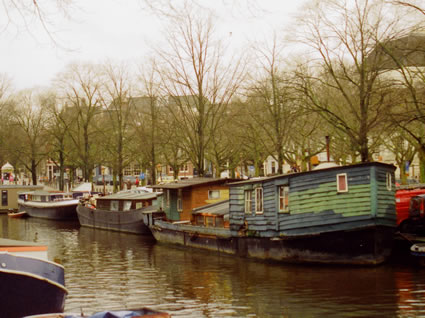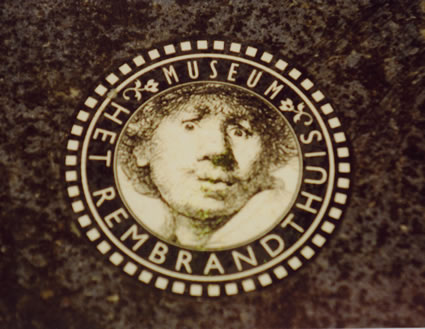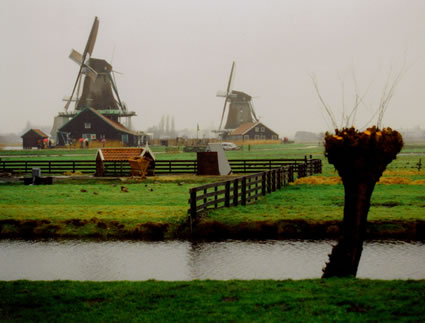How to Travel and Learn from the Art Masters in Amsterdam
Off-Season is a Great Time for Cultural Exploration Without the Crowds
Article and Photos by Sara R. Massey

|
|
Houseboat on a canal in Amsterdam.
|
As an artist I never seen to get enough of visiting art museums, and so when winter arrived I started looking for inexpensive flights to Europe. This year I chose Amsterdam to visit the Rijksmuseum and the nearby van Gogh Museum.
The trip started with a big laugh as the immigration man at Schiphol airport asked me, “Why are you visiting the Netherlands?” With a straight face I replied, “For the weather, of course,” and he dissolved into laughter. Still, if the Dutch can ride their bicycles in the rain, walks in the rain are fine with me.
Setting out with my brolly (umbrella) and “singing in the rain” I headed for the Riijksmuseum to see the masterpieces and wondering what I might learn. In winter there rarely are many lines of people. I walk right in. And there is Vermeer — the light of Vermeer’s “Kitchen Maid” and “Woman Reading a Letter” was pure delight; the shades of blue amaze. How did he do that? The utter simplicity of his compositions with the impressive reflections was awe inspiring. I could sketch for years and never approach his technical skill. Then there was Rembrandt’s famous “Night Watch” with all the amazing neck ruffles. I trace the rhythms of the line with my eyes as time passes before this art for the ages.
The next day, after studying my map, I set out for the Rembrandt House Museum located near the Waterlooplein Flea Market where I learned about etchings. It seems that Rembrandt’s forte was etchings, not painting — that was how he made his living. His 17th century home and museum was by far the highlight of my Amsterdam wanderings.
During the years Rembrandt lived in the house, he tutored several pupils. I peeked over the shoulder of Dutch artist Rene Klarenbeek as he attempted to master Rembrandt’s painting technique by copying Rembrandt’s goddess “Minerva,” which made my eyes ache it was so beautiful. The artist took time to pleasantly answer my questions and explain his apprenticeship at the museum.
A climb up the steep winding stairs reveals a floor with Rembrandt’s etchings and explanatory panels. I spent a lot of time with the young woman who demonstrated the etching process used by Rembrandt that is virtually the same as the process used today.

|
|
Rembrandt's face is everywhere. (Rembrandt house logo in sidewalk).
|
What a grand day with lots of new learning and images for my memory to take back home. The museum/home was warm and cozy with everyone friendly and helpful, and right next door is a café, Rembrandt’s Corner, where I enjoyed a steaming bowl of split pea soup and bread as only the Europeans make — before wandering in the drizzle to the flea market.
Not being quite the hearty Dutchman and beginning to get fatigued from walking in the rain it was time for a ½ day tour outside of Amsterdam: The windmills along the River Zaan and the fishing villages of Marken and Volendam. The tour could be renamed “Stereotypes of Holland,” and included a visit to the shoemaker making the wooden clogs, which the Dutch really do wear as protection from the cold and wet when working in the fields, a visit to the cheese farm with the rosy-cheeked girl in her costumed skirt and blouse demonstrating the curds and whey process of making gouda cheese, a walk among the irrigation locks and canals with picturesque windmills in the background, and, lastly, wandering the fishing village, now the tourist town of Volendam to enjoy apple pie topped with thick rich whipped cream at The Cow (de Koe).

|
|
The picturesque windmills along the River Zaan.
|
But I was not going home without a day at the van Gogh Museum. I thought that I had seen a lot of van Gogh from past museums I have visited, but this museum was a fantastic surprise. The museum included works from his entire lifetime and included paintings I had never heard of. The dark somber colors of the peasants with exaggerated features in his early work were a surprise, as well the paintings completed at the mental health clinic in Saint-Rémy that included the “Wheatfield with a Reaper.” There were several floors of paintings, including those inspired by Japanese woodcuts. I had no idea that he had done so many — with all preserved by brother Theo.
Everywhere I went people would chat and help me out — whether it was to find the museum on the map, or find the nearest Dutch pancake house, or just a chat about the weather. As I boarded the plane back to the United States I thought about what a grand escape from the winter doldrums it had been to enjoy the Dutch people and learn from the masters during this off-season trip to Amsterdam. Just don’t forget your umbrella!
Sara Massey, retired from a cultural museum in Texas, is a freelance writer and artist, now 70 years old, who annually enjoys traveling solo.
|
